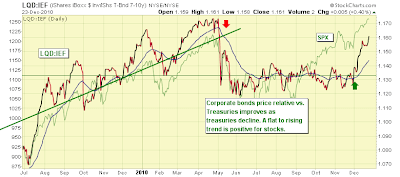Equity indices continue to make new highs as the uptrend remains intact. Although traditional momentum indicators are overbought, markets can remain overbought for quite a while. A divergence in RSI (lower high while price attained a higher high) is evident in the major indices. This bodes watching as an early sign of a reversal in price trend, however, the timing of such a reversal is suspect (and RSI has been known on occasion to work itself out to ultimately turn consistent with trend).
Investor and money manager polls remain at extreme bullish levels. With many Wall Street projections for the new year exuding double-digit projected gains, caution in joining the ranks of bullish enthusiasm is advised.
The McClellan Oscillator readings turned more bullish last week, as price moved above its 20-day moving average and the Summation Index closes in on a bullish cross (10 points away). This indicator has been a reliable measure of trend. See the chart below:
Although financials have taken on a leadership position vs. SPX, discretionary stocks have weakened at the expense of a bottoming pattern in staples. The latter indicator may suggest a more cautious stance as equity prices have risen so far so quickly.
Several more positives have surfaced. The relative strength between corporate bonds and Treasuries continues to improve, breaking out of a trading range in place since June (see chart below).
Continued leadership in small caps and growth stocks rounds out the positive signals supporting the uptrend in equities.
Markets reliably pause following a sustained period of gains. SPX is up over 4% in December. With the risk of a trend change or consolidation/correction increasing, our strategy is focusing on capital preservation and protection of gains through tighter stops, covered call sales, with a short hedge for added insurance. This will have the effect of underperforming a strong uptrend (but still generating positive returns), with downside protection.
Click here for the updated Market Tour on Stockcharts.com.
Chart Pattern Indicator: What's the Reading?
1 week ago






